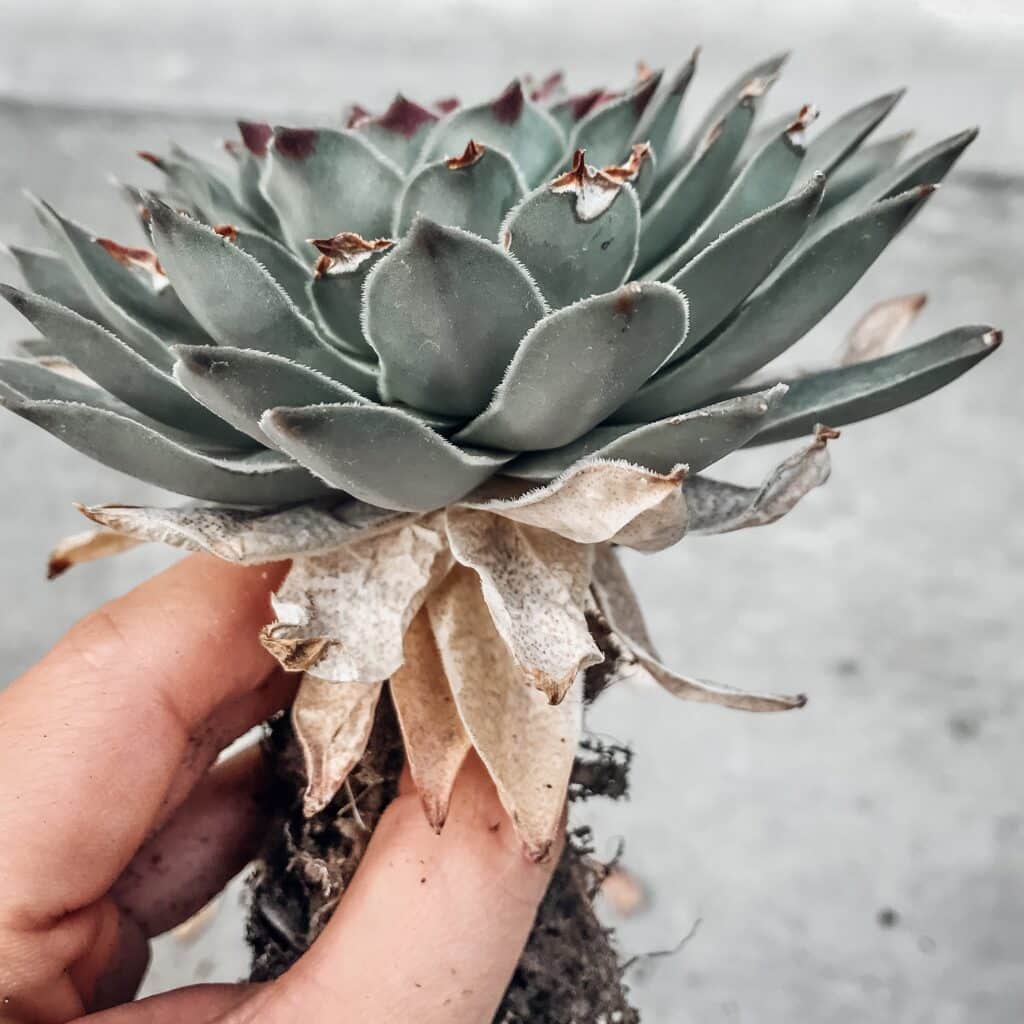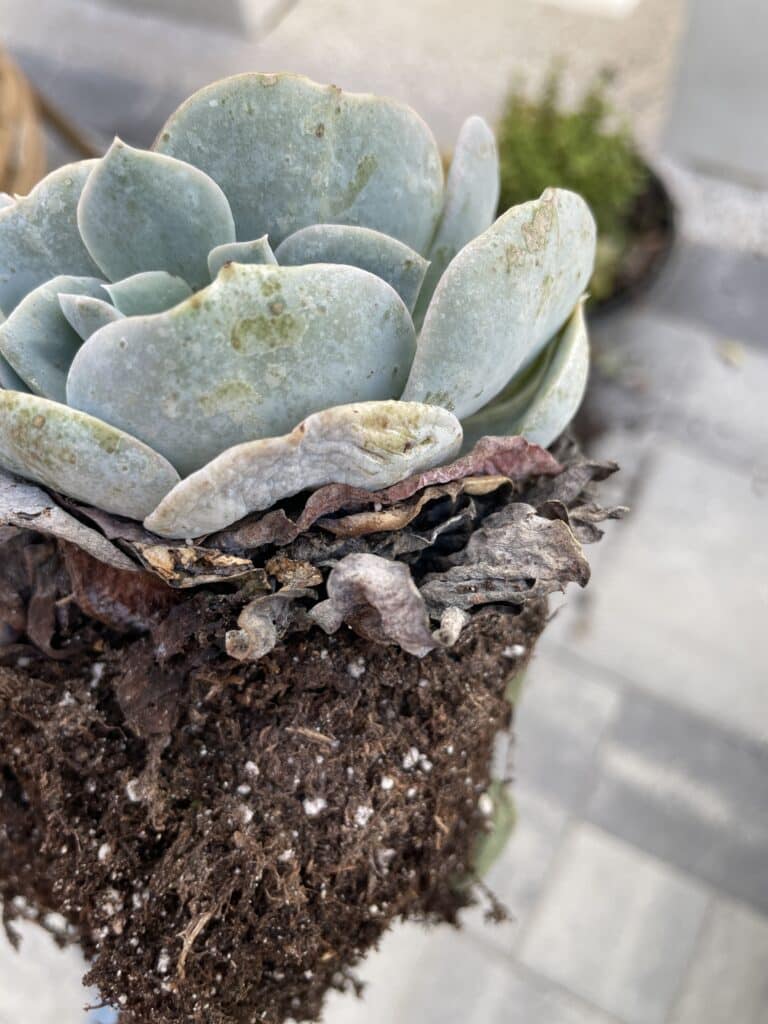Succulent Leaves Falling Off When Touched: Top Causes and Solutions
Succulents are low-maintenance plants but problems, such as leaf drop, can sometimes arise, leaving us feeling frustrated! So if you’re wondering why the leaves are falling off your succulent when touched, you’re not alone.
The good news is that leaf loss is not an uncommon occurrence and there are a number of reasons it happens. Luckily, there are solutions for it as well.

Succulents can be pretty easy to handle compared to other plants but they DO have needs that should be met if you want them to look their best. Those needs include bright light, well-draining soil, and an appropriate watering schedule.
If you’re losing leaves left and right, your plant might be trying to survive in harsh conditions.
These harsh conditions might include:
- Excess water
- Too little water
- Natural growth cycle
- Not enough light
- Extreme temperatures (hot or cold)
Let’s go over a few things to see if you can pinpoint the problem and help out your plant!
Overwatering Your Succulents Can Cause Leaf Drop
CAUSE: Overwatering
Succulents are famous for their fleshy leaves that are very unique to other plants. Succulent leaves are able to hold enough water in their leaves to help them survive extreme drought conditions.
While this is a wonderful quality and part of what makes them so low-maintenance, it’s also a reason they’re so sensitive to overwatering.

Overwatering is actually one of the most common reasons your succulents are losing leaves when you touch them. This is because the leaves swell and become so heavy from too much water that even a slight touch can knock them off their stem.
This is why learning how to water succulents is such a huge part of mastering succulent care.
Signs of overwatering include translucent, yellow leaves that are mushy to the touch. Remember that succulent leaves should feel firm!

Unfortunately, overwatering can cause root rot pretty quickly because of excess moisture, which can kill the entire plant if you don’t act fast. To check for root rot, take the plant out of its pot and take a look at the roots. If the roots look mushy or black, they’re rotting.
If some of the leaves on the succulent still look healthy, you can take them off the stem and try your hand at succulent propagation.

Hopefully, your plant hasn’t reached the point of root rot.
SOLUTION: In this case, stop watering until the soil in the entire pot is completely dry. This should take about a week or a week and a half. Once you feel that the soil is dry, take your watering can and water the soil until you see water escape from the drainage hole (drainage holes are a must-have!).
Then, wait to water again until the soil is dry. This should help you avoid overwatering your plant.
Underwatering Can Harm Succulent Leaves
Cause: Underwatering
Fallen leaves can also be the result of underwatering. When a succulent doesn’t receive the water it needs, it can’t maintain healthy leaves.
Lack of water for long periods of time (usually several weeks or months) can put enormous stress on a plant, causing it to drop its leaves in an attempt to conserve as much energy as it can.
This can happen quickly in dry environments, especially during the summer months, which is why it’s important to follow a regular watering schedule.

Signs of an underwatered succulent include brown, crispy leaves from the center or the top of the plant. Outdoor succulents are usually more prone to underwatering than indoor succulents because they’re usually out in full sun.
SOLUTION: The best way to avoid underwatering is to check the soil once a week (my day to check my plants for moisture is Saturday! This way, you’ll be made aware of your plant’s water needs before problems arise.
If the soil feels dry, it’s time to water. Water generously until you see water escape from the drainage hole.
Lower Leaves Fall off the Stem to Make Way for New Leaves
Cause: Natural Process; Energy Shift in the Plant
Succulents naturally drop older leaves to make way for newer leaves. If you notice crispy leaves drying out from the bottom of the plant, this is a natural process and no cause for alarm.

It’s a good thing! Your plant is using its energy to grow and expand.
Keep in mind that most succulents, particularly rosette types, grow new leaves from the center as the oldest leaves near the bottom of the stem start to become wrinkly and crispy.

SOLUTION: If this is the leaf drop you’re worried about, then you can stop worrying; the rest of the plant is healthy. If it bothers you to see crispy, dead leaves then you can simply tug them off the stem and discard them.
Extreme Temperatures Cause Leaves to Drop
Cause: Unideal weather might be shocking the plant
It’s common to think that succulents can withstand the harshest of conditions but that’s simply not true. Extreme heat and extreme cold can really affect the health of your plants.
These conditions can shock your succulent and make it drop its leaves in an act of self-preservation. The more leaves a plant has, the more energy it needs to use to keep itself healthy.

The majority of succulents can’t take very cold weather, so if you live in an area that gets below 30 degrees at night, you should bring your succulents indoors for the winter.
Environmental stress is a common problem and it’s not easy for a plant to continue performing well under such conditions.
Just as they can’t tolerate very cold temperatures, succulents have a tough time spending the summer out in an extremely hot environment, especially if underwatered.
Anything past 90 degrees Fahrenheit presents a problem for most succulents, especially new plants. It’s a good idea to offter shade during heat waves (try covering them with shade cloth!).

You should also be watering your succulents every two or three days during heat waves. Make sure to water in the morning so the succulent soil has enough time to absorb the water before the heat sets in for the day.
During the summer months, it’s important that succulent owners take extra care of their succulents.
Sunburn and scorched roots can quickly kill or damage a succulent, so providing extra shade from the afternoon sun and making sure to water in the morning can do a lot to prevent sun damage.
If you can move your succulents to bright shade, even better!
SOLUTION: Bring your succulents indoors for the winter if temperatures get extreme. During the summer, water well and water regularly. Try to move succulents into the shade, if you can, during heat waves.
Low Light Conditions Can Make Succulents Drop Their Leaves
Succulents thrive on light. It’s how they retain their beautiful compact shape and gather enough energy to make new leaves. There aren’t very many plants that can thrive on low light and still look beautiful (pothos plants are one of them!) but succulents should be given enough sunlight every day.
Succulents typically need around 6 hours of direct sunlight every day, especially during their growing season.

A lack of sunlight for an extended period of time will force the plant to retain its last bit of energy, and eventually make it drop its leaves.

Solution: Move your succulent to a sunnier spot outdoors or in your home (you can even use a grow light if sunlight is hard to come by in your house). If you’ve kept it far away from a light source, this might be the main reason the leaves are falling off at the slightest touch.
Just a note from a long-time succulent owner: Some succulents are naturally prone to leaf drop at the slightest touch so it’s super important to avoid touching them!
Donkey tail or Burro’s tail (Sedum morganianum) is VERY sensitive to touch and their healthy, fleshy leaves can be knocked off their stem very easily. If this bothers you, I’d recommend you avoid purchasing these beautiful succulent plants.
We’ve now covered all of the main reasons your succulent leaves are falling off when touched.
Hopefully, you’ll be able to easily identify what the cause so you can quickly address it with the appropriate solution.
Good luck!